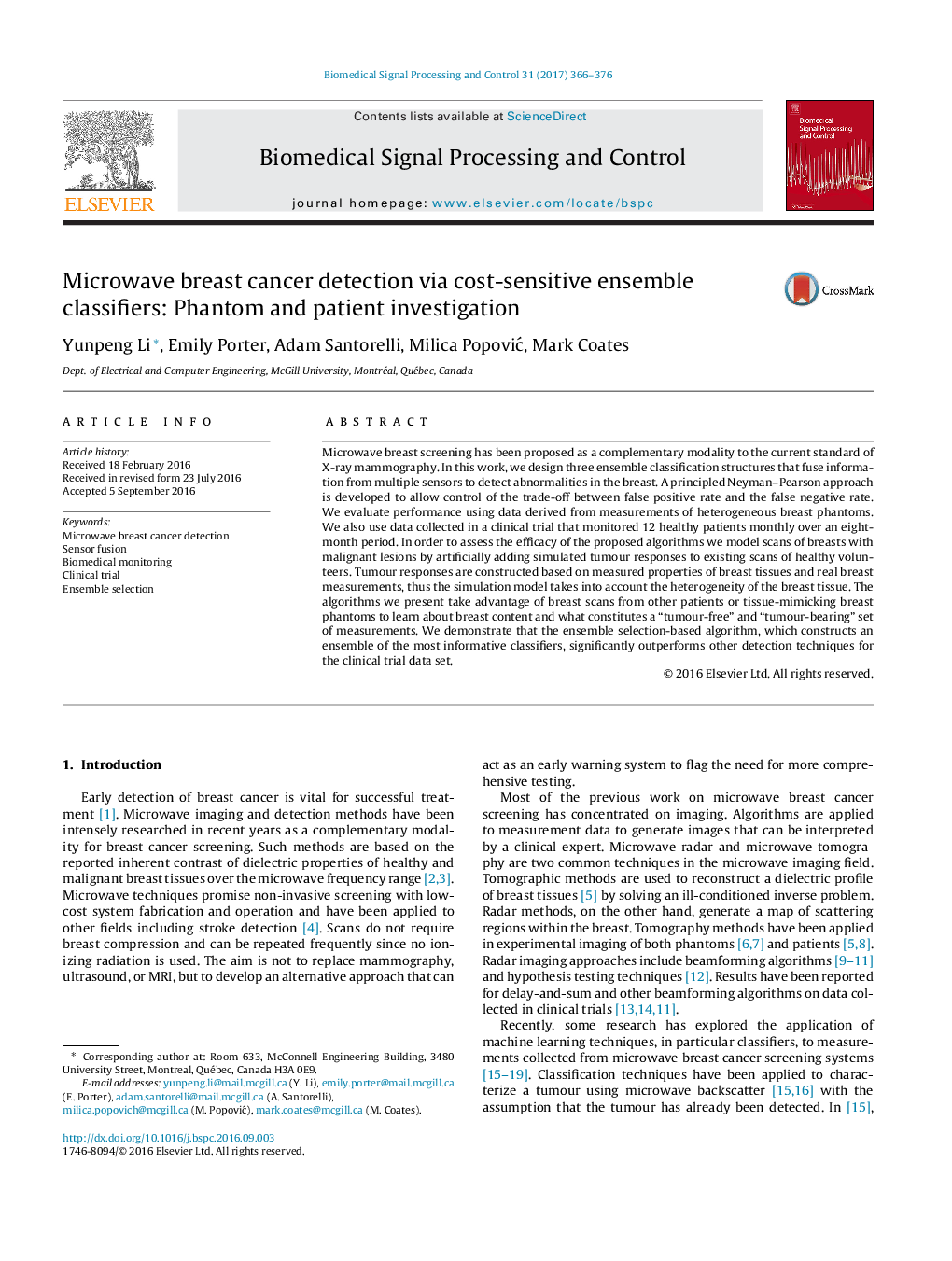| کد مقاله | کد نشریه | سال انتشار | مقاله انگلیسی | نسخه تمام متن |
|---|---|---|---|---|
| 6951124 | 1451649 | 2017 | 11 صفحه PDF | دانلود رایگان |
عنوان انگلیسی مقاله ISI
Microwave breast cancer detection via cost-sensitive ensemble classifiers: Phantom and patient investigation
ترجمه فارسی عنوان
تشخیص سرطان پستان مایکروویو با استفاده از طبقه بندی های حساس به هزینه: بررسی فانتوم و بیمار
دانلود مقاله + سفارش ترجمه
دانلود مقاله ISI انگلیسی
رایگان برای ایرانیان
کلمات کلیدی
تشخیص سرطان پستان مایکروویو، همجوشی سنسور، نظارت بر زیست پزشکی، کارازمایی بالینی، انتخاب گروهی،
ترجمه چکیده
غربالگری پستان مایکروویو به عنوان یک روش مکمل برای استاندارد فعلی ماموگرافی اشعه ایکس پیشنهاد شده است. در این کار، ما سه ساختار طبقه بندی گروهی را طراحی می کنیم که اطلاعات را از چندین سنسور برای شناسایی ناهنجاری های پستان در آورند. رویکرد اصلی نیمان-پیرسون برای کنترل اختلاف بین میزان مثبت کاذب و نرخ منفی کاذب توسعه داده شده است. ما عملکرد را با استفاده از داده های حاصل از اندازه گیری فانتوم های پنهان ناهمگن ارزیابی می کنیم. ما همچنین از داده های جمع آوری شده در یک کارآزمایی بالینی استفاده می کنیم که 12 بیمار سالم را طی یک دوره 8 ماهه بررسی می کند. برای ارزیابی اثربخشی الگوریتم های پیشنهادی، اسکن سینه ها با ضایعات بدخیم را با استفاده مصنوعی از پاسخ های تومور شبیه سازی شده به اسکن های موجود از داوطلبان سالم مدل سازی می کنیم. پاسخ های تومور بر اساس خواص اندازه گیری شده بافت های پستان و اندازه گیری های پستان واقعی ساخته می شوند، بنابراین مدل شبیه سازی ناهمگونی بافت پستان را در نظر می گیرد. الگوریتم هایی که در حال حاضر ارائه می کنیم، از اسکن پستان از سایر بیماران یا فانتوم های پستان شبیه سازی بافت استفاده می کنیم تا در مورد محتوای سینه یاد بگیرند و چه چیزی تومور آزاد را تشخیص می دهند؟ و تومور تحریک مجموعه ای از اندازه گیری ها ما نشان می دهیم که الگوریتم مبتنی بر انتخاب گروه، که مجموعه ای از طبقه بندی های پر محتوایی را ایجاد می کند، به طور قابل توجهی از تکنیک های تشخیص دیگر برای داده های آزمایشگاهی بالینی بهتر است.
موضوعات مرتبط
مهندسی و علوم پایه
مهندسی کامپیوتر
پردازش سیگنال
چکیده انگلیسی
Microwave breast screening has been proposed as a complementary modality to the current standard of X-ray mammography. In this work, we design three ensemble classification structures that fuse information from multiple sensors to detect abnormalities in the breast. A principled Neyman-Pearson approach is developed to allow control of the trade-off between false positive rate and the false negative rate. We evaluate performance using data derived from measurements of heterogeneous breast phantoms. We also use data collected in a clinical trial that monitored 12 healthy patients monthly over an eight-month period. In order to assess the efficacy of the proposed algorithms we model scans of breasts with malignant lesions by artificially adding simulated tumour responses to existing scans of healthy volunteers. Tumour responses are constructed based on measured properties of breast tissues and real breast measurements, thus the simulation model takes into account the heterogeneity of the breast tissue. The algorithms we present take advantage of breast scans from other patients or tissue-mimicking breast phantoms to learn about breast content and what constitutes a “tumour-free” and “tumour-bearing” set of measurements. We demonstrate that the ensemble selection-based algorithm, which constructs an ensemble of the most informative classifiers, significantly outperforms other detection techniques for the clinical trial data set.
ناشر
Database: Elsevier - ScienceDirect (ساینس دایرکت)
Journal: Biomedical Signal Processing and Control - Volume 31, January 2017, Pages 366-376
Journal: Biomedical Signal Processing and Control - Volume 31, January 2017, Pages 366-376
نویسندگان
Yunpeng Li, Emily Porter, Adam Santorelli, Milica PopoviÄ, Mark Coates,
